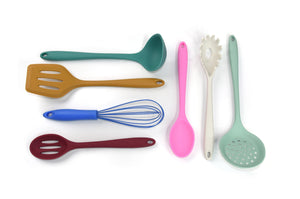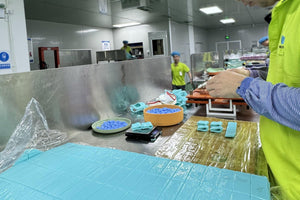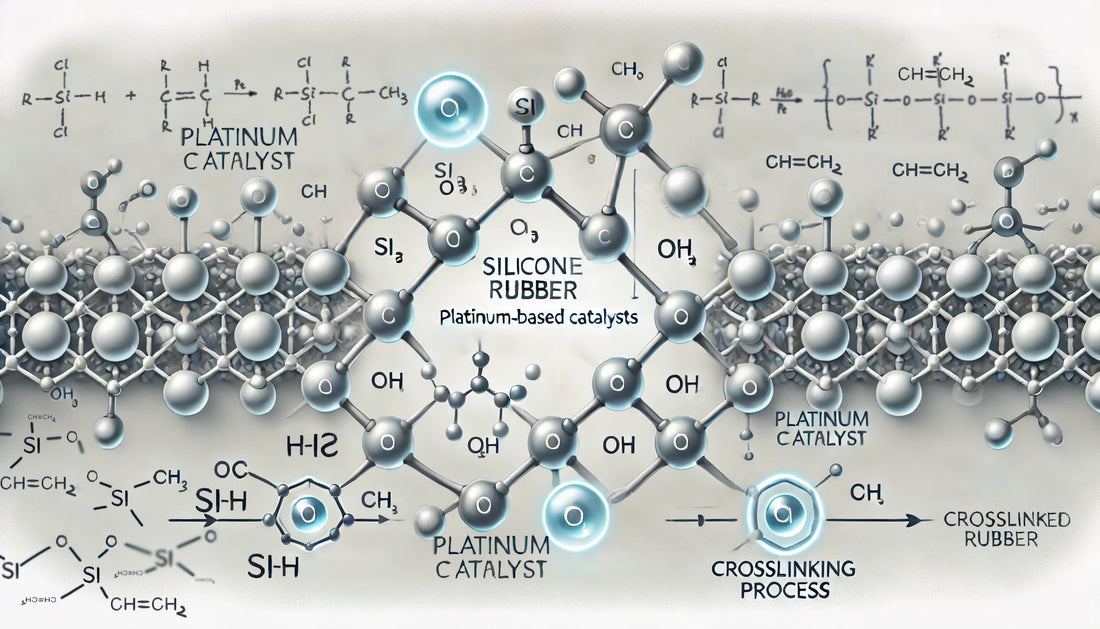Silicone rubber has become a cornerstone material in industries ranging from medical to automotive due to its unmatched versatility, resilience, and safety. A pivotal factor in the performance of silicone rubber lies in the curing process, particularly when platinum-based catalysts are employed. This blog explores the science, advantages, and applications of platinum-cured silicone rubber, highlighting why it’s the gold standard for high-performance elastomers.
What Are Platinum-Based Catalysts?
The silicone industry extensively uses the platinum-catalyzed hydrosilylation reaction, where a silicon-hydrogen (Si-H) bond reacts with an unsaturated carbon-carbon double bond (C=C) in an olefin. This reaction forms a silicon-carbon (Si-C) bond, which is fundamental to creating high-performance silicone materials.

*The R represents an organic group attached to the silicon (Si) atom. These R groups can vary depending on the specific compound and desired properties.
In the production of silicone rubber, hydrosilylation plays a key role in linking siloxane (Si-O-Si) chains to create the flexible, durable structure characteristic of silicone rubber. The process involves the addition of silane groups to polymer chains through hydrosilylation, forming the backbone of the rubber material.
Here's how it works in the context of silicone rubber production:
1. Synthesis of Prepolymers (Vinyl-terminated Silicones)
The first step is to synthesize silicone prepolymers, which are typically vinyl-terminated polysiloxanes (polymers with a vinyl group at each end). These prepolymers are often created by combining silanes like R2SiCl2 with water and a catalyst to form siloxane linkages, followed by introducing vinyl groups (CH=CH2) via hydrosilylation or other reactions.

2. Crosslinking (Hydrosilylation Reaction)
- To convert the prepolymer into a crosslinked silicone rubber, hydrosilylation is used to introduce a crosslinking agent, which is typically a silicon hydride (Si-H) compound, such as a hydrosilane or silane crosslinker (e.g., a silane that has both Si-H and other functional groups).
- When this crosslinking agent is added to the prepolymer, the Si-H group reacts with the vinyl groups on the prepolymer chains via the hydrosilylation reaction (the Si-H adds across the double bonds).

- This reaction results in the formation of siloxane crosslinks between polymer chains, making the material more three-dimensional and transforming it from a liquid or gel into a solid rubber.
3. Curing and Final Formation
- The addition of the crosslinker and the application of heat or a catalyst causes the polymer network to cure, forming silicone rubber. The crosslinked structure gives the rubber its characteristic flexibility, heat resistance, and durability.
- This is also why silicone rubbers can maintain their properties in a wide range of temperatures and environments, from extreme heat to low temperatures, without losing flexibility.
Key Benefits of Hydrosilylation in Silicone Rubber Production:
- Precise control over crosslinking: Hydrosilylation allows for fine-tuned control over the density and structure of the crosslinks, which influences the rubber's properties like elasticity, hardness, and resistance to chemicals and temperature.
- Versatility: It enables the incorporation of various functional groups (such as alkyl, aryl, or even fluorine groups) into the silicone polymer, tailoring the rubber for specific uses.
- Efficiency: The reaction can be catalyzed efficiently using platinum-based catalysts, ensuring high yield and uniformity in the final product.
This technology is widely used to create silicone rubbers for applications ranging from automotive seals to medical devices and kitchen products, all benefiting from the material’s heat resistance, flexibility, and chemical stability.
Key Benefits of Platinum-Cured Silicone Rubber
1. Enhanced Mechanical Properties
Platinum-cured silicone rubber exhibits superior elasticity, tensile strength, and tear resistance compared to peroxide-cured alternatives. This makes it ideal for demanding environments where durability is critical.
2. Exceptional Purity
The addition-cure process does not produce volatile organic compounds (VOCs) or other harmful byproducts. As a result, platinum-cured silicone is often used in medical devices, food-grade applications, and baby products.
3. Thermal Stability
Silicone rubber cured with platinum catalysts can withstand extreme temperatures, maintaining its flexibility and performance in conditions ranging from -60°C to 200°C. This thermal resilience is indispensable for aerospace, automotive, and industrial applications.
4. Chemical Resistance
Platinum-cured silicones resist a wide range of chemicals, including oils, solvents, and acids. This property ensures longevity and reliability in harsh chemical environments.
5. Biocompatibility
Thanks to its purity and hypoallergenic properties, platinum-cured silicone rubber is widely used in medical implants, surgical tools, and skin-contact applications such as prosthetics and wearables.
Applications of Platinum-Cured Silicone Rubber
Medical Devices
From catheters and tubing to implantable devices, platinum-cured silicone rubber is a mainstay in the healthcare sector. Its biocompatibility and ability to withstand sterilization processes make it a reliable choice.
Food and Beverage: In the food industry, silicone rubber is used for baking molds, seals, and tubing. The absence of harmful byproducts ensures compliance with stringent food safety standards.
Electronics: Platinum-cured silicones provide insulation and protection for sensitive electronic components, particularly in high-temperature or high-voltage environments.
Baby Products: Products such as pacifiers, bottle nipples, and teething toys benefit from the non-toxic and hypoallergenic nature of platinum-cured silicone rubber.
Automotive and Aerospace: Silicone rubber’s ability to perform under extreme temperatures and resist chemicals makes it indispensable for gaskets, seals, and vibration dampeners in automotive and aerospace industries.
Challenges and Considerations
Strength: Unfilled silicone rubber possesses extremely poor mechanical strength, crumbling under minimal pressure, such as a fingernail. To enhance strength, the most effective reinforcing filler is hexamethyldisilazane-treated fumed silica. For applications requiring clarity, alternative reinforcing agents must be used to maintain transparency.
Hardness: The hardness of silicone rubber is directly related to the density of its crosslinking. A higher crosslink density results in greater hardness.
Consistency: The consistency of silicone rubber is determined by the viscosity of the base material and the incorporation of low surface area fillers like calcium carbonate or precipitated silica.
Cure Time: The choice of platinum catalyst significantly influences the curing temperature:
- Platinum in vinyldisiloxanes is typically used for room-temperature curing.
- Platinum in cyclic vinyl-siloxanes is better suited for high-temperature curing.
Work Time: Work time is directly related to the curing speed. Factors like temperature and the use of moderators or inhibitors can control it:
- Moderators: Slow down the platinum catalyst without stopping it.
- Inhibitors: Temporarily halt the platinum catalyst to provide a shut-down period.
Shelf Life: The shelf life of compounded silicone can be affected by various factors, including:
- Exposure to moisture.
- Differential adsorption of reactive components by fillers.
- Trace impurities causing inhibitory effects.
Compounding: Silicone rubbers (except for the lowest consistency types) are typically compounded using sigma blade mixers, two-roll mills, or, for large-scale production, twin-screw extruders.
About Author
We are dedicated to pushing the boundaries of possibility in silicone product manufacturing and our extensive range of inhouse designs and molds across baby, pet, homewares and more allows companies to customize and create products specific for their brand and market needs.
Whether you are looking for a company to bring your ideas and brand to life or looking for ready to go items with packaging and branding, WOLIFE is ready to help your business grow.
WOLIFE looks forward to collaborating with you!


 Using LSR in Hearing Components
Using LSR in Hearing Components Why Silicone Cooking Utensils and Baking Trays Don’t Melt – The Science Explained
Why Silicone Cooking Utensils and Baking Trays Don’t Melt – The Science Explained 10 Creative Products You Didn’t Know Could Be Made with Silicone
10 Creative Products You Didn’t Know Could Be Made with Silicone Common Quality Control Challenges in Silicone Manufacturing
Common Quality Control Challenges in Silicone Manufacturing